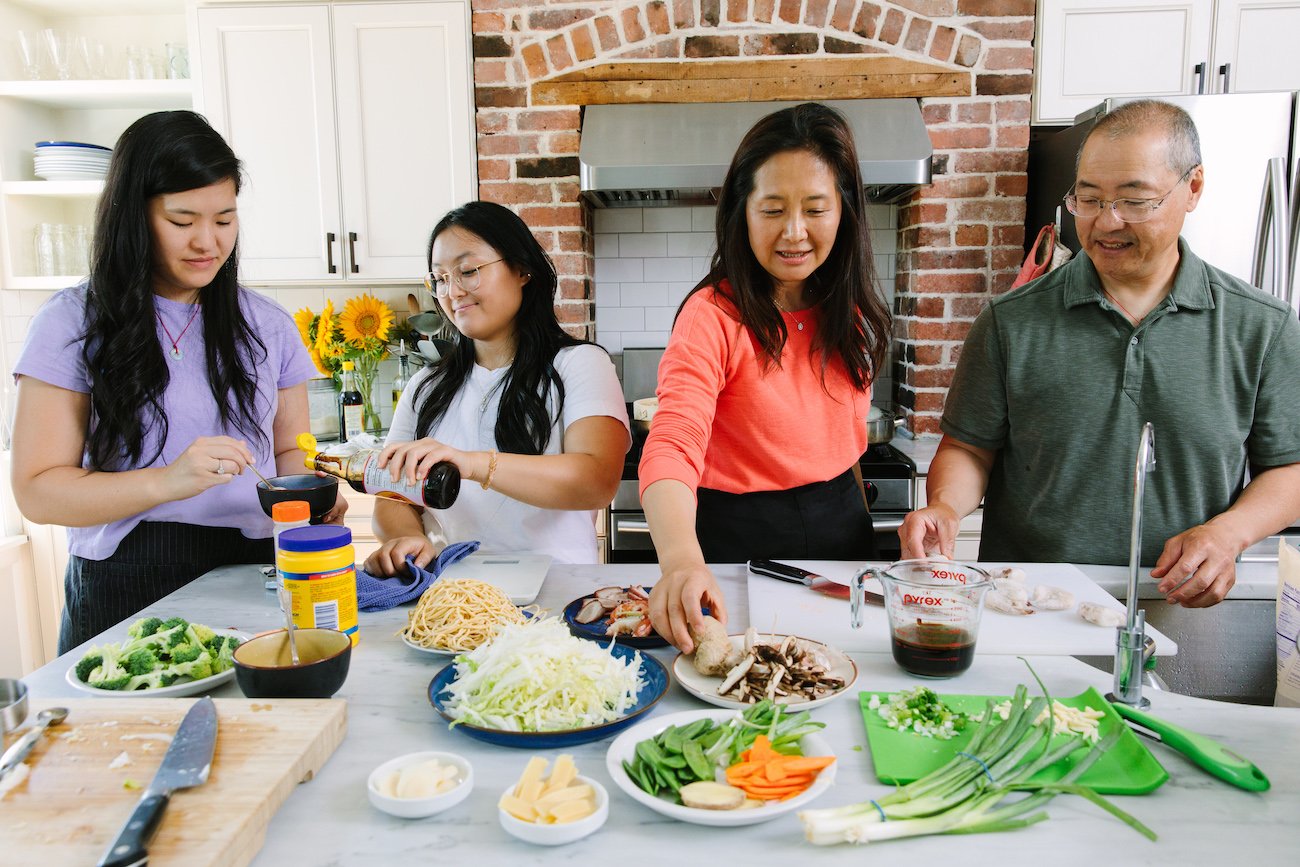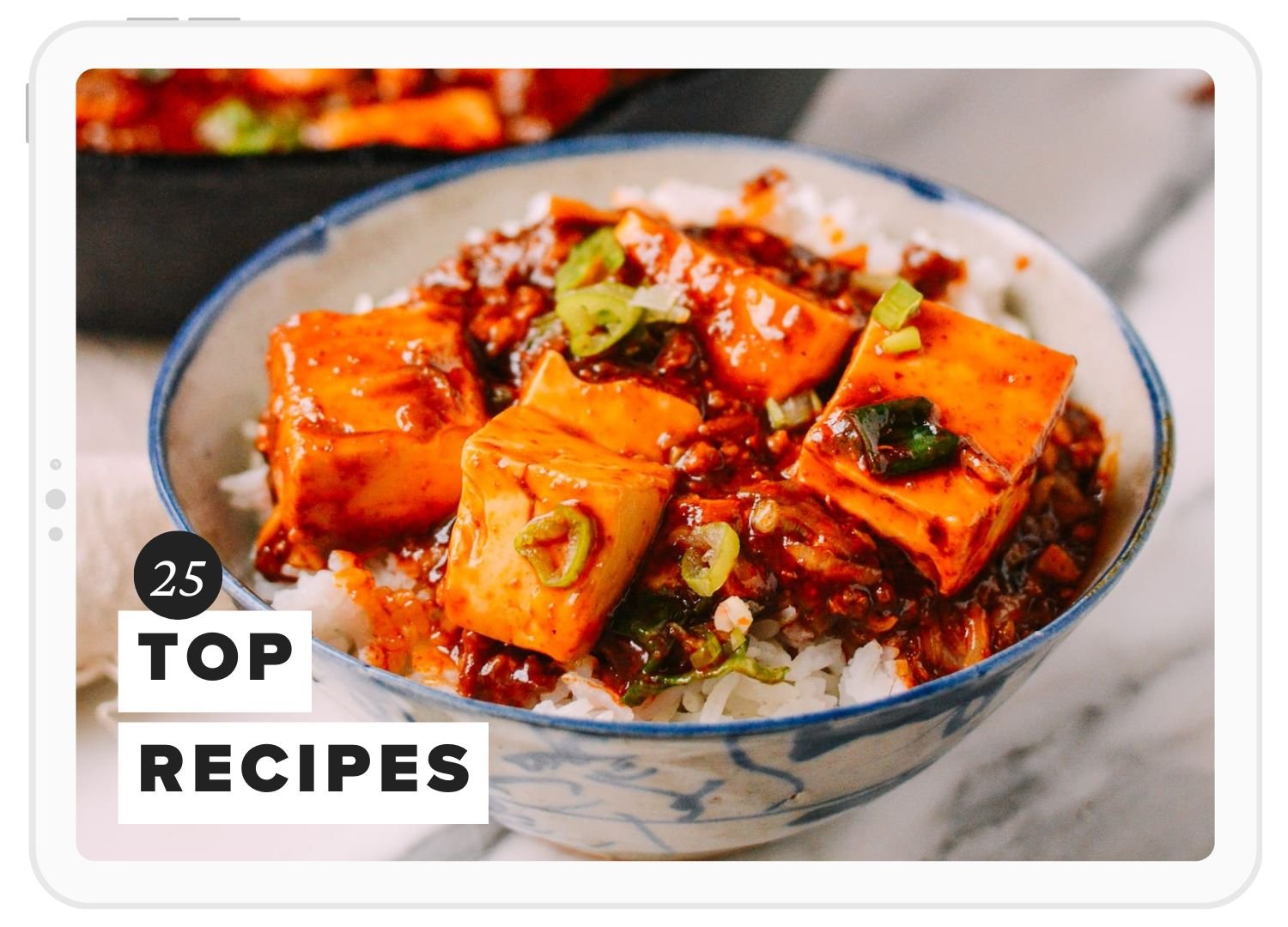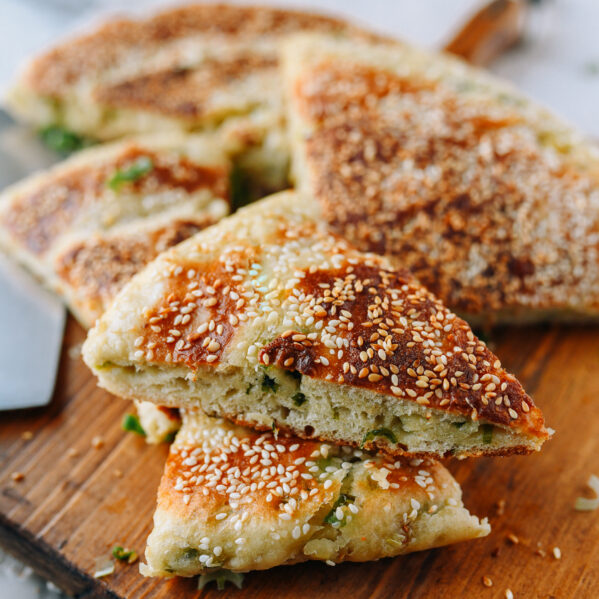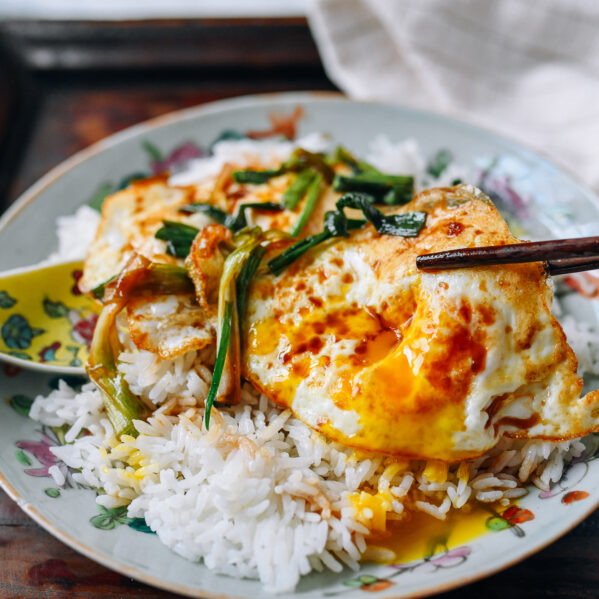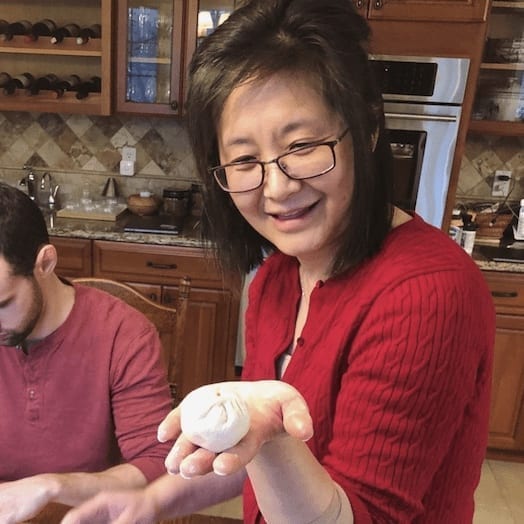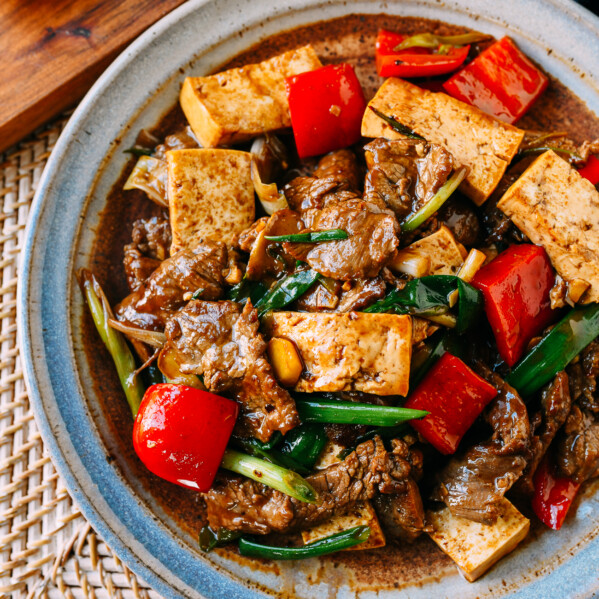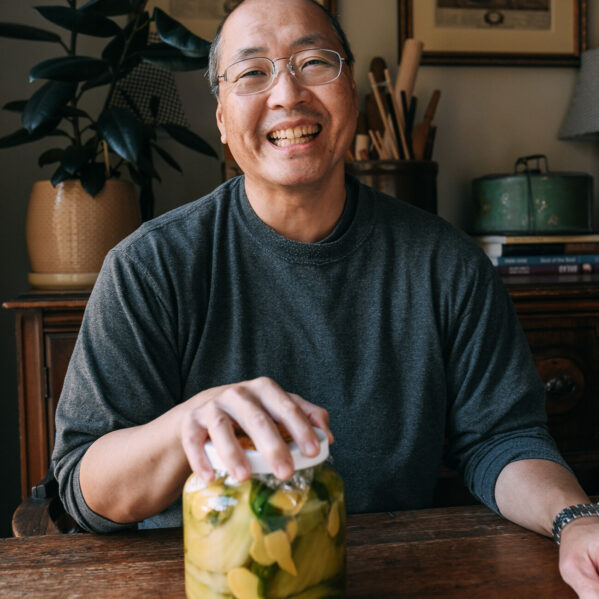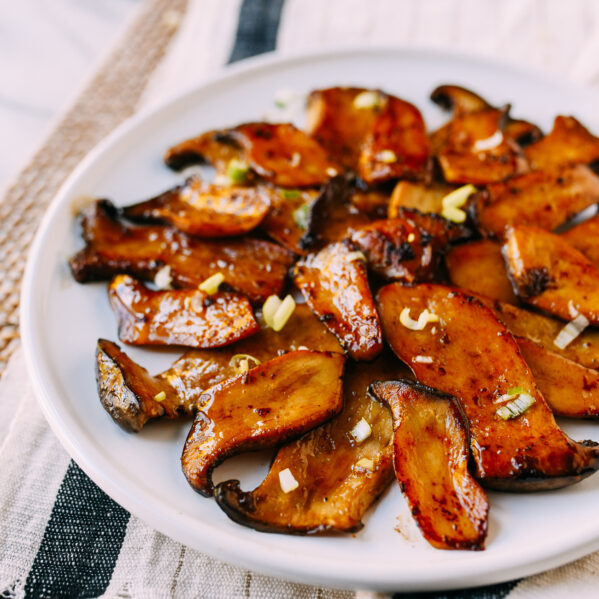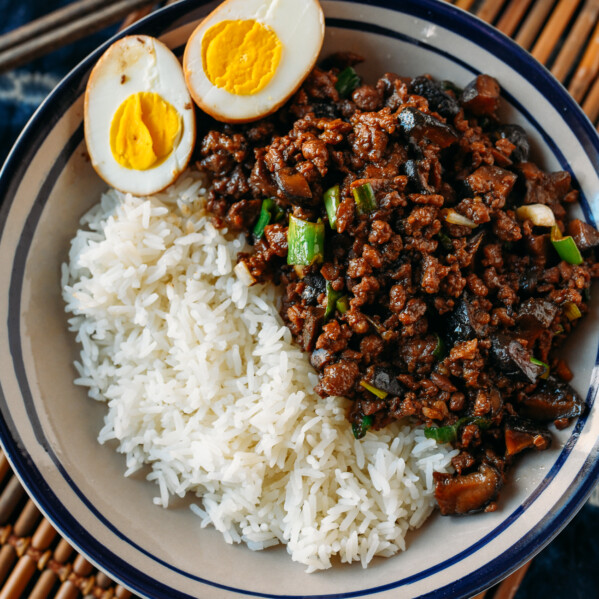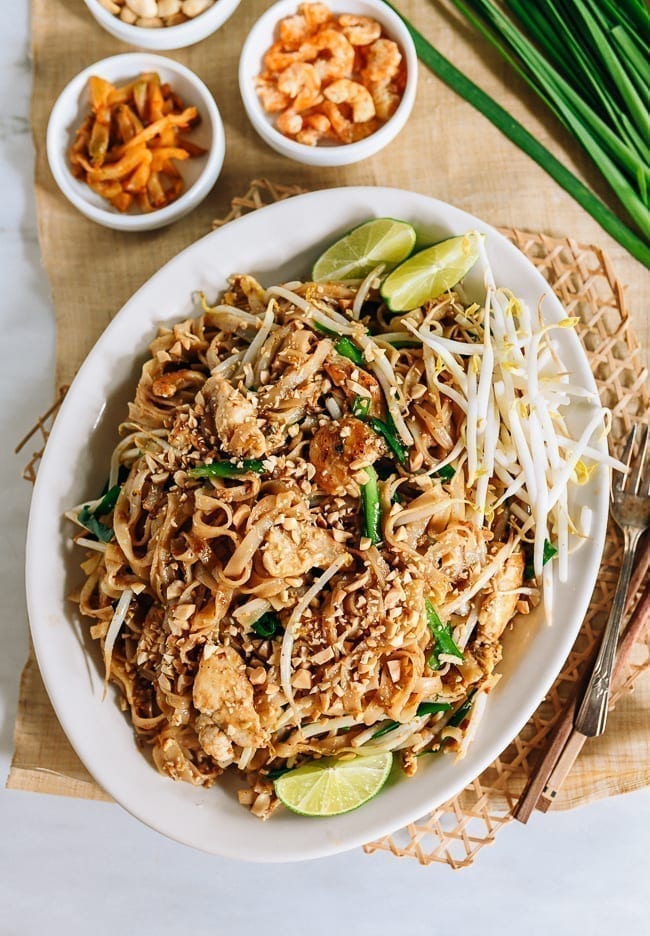
Pad Thai is like a warm blanket. It’s a comfort food of our age, with those chewy noodles, crunchy peanuts, the sweet and tangy sauce, and plenty of chives, bean sprouts, and chicken to make it a full meal.
To develop this recipe, I carefully pored over many videos of street food vendors in the process of making this signature dish, to catch every detail and addition. This recipe has all the ingredients and information you need to make Pad Thai at home.
Note: This recipe was originally developed in the summer of 2020, and published on September 28, 2020. We have since updated it with more detail and additional ingredients photos. Enjoy!
A Complex, Full-flavored Pad Thai (Hold the Ketchup!)
I had a friend who traveled to Thailand and spent months eating Pad Thai on the streets of Bangkok. When she returned, she declared she could never go back to the bright red, too-sweet stuff often served up stateside.
We’ve done our best to emulate the perfect blend of salty, sweet, pickly, shrimpy goodness that goes into a good authentic pad Thai, made with crowd-pleasing chicken. If you prefer Shrimp Pad Thai, head to my dad’s recipe!
Key Ingredients for the Best Pad Thai:
There are a few vital ingredients for making an excellent—not just good—pad Thai:
- Tamarind: Mainstream Pad Thai in the U.S. is often a super sweet, red-hued concoction involving lots of ketchup. Traditionally, the tangy sweetness of pad Thai comes from sugar and tamarind paste. In some of our other posts, we use tamarind concentrate from a jar, and some of you readers pointed out that there’s nothing like the pulp, and we agree! We tested this recipe with both the tamarind concentrate from a jar, and our own tamarind concentrate using tamarind pulp, and the difference in flavor was significant! Both will work, but definitely get the tamarind pulp if you can find it.
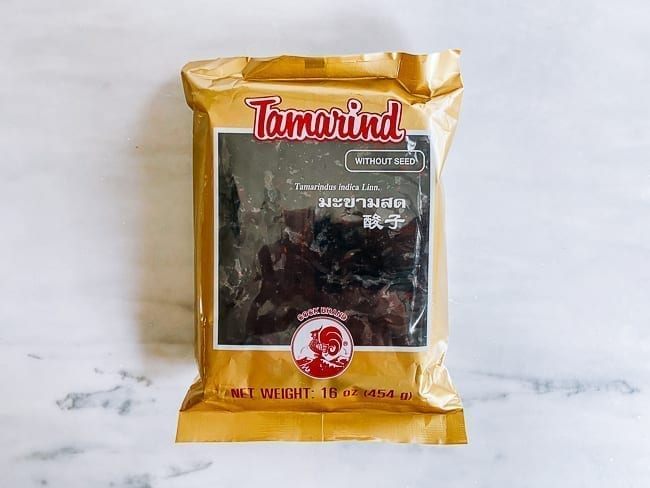
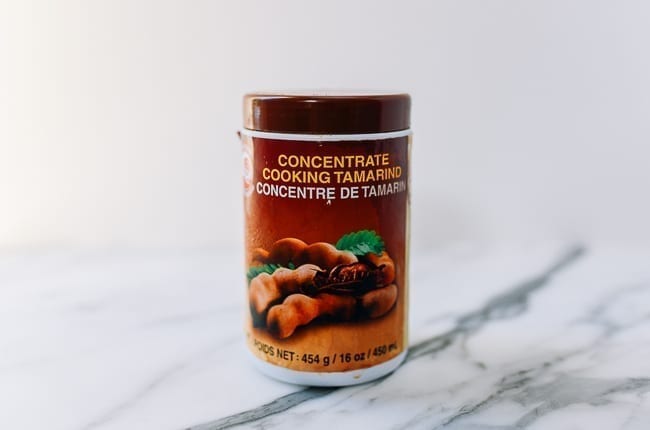
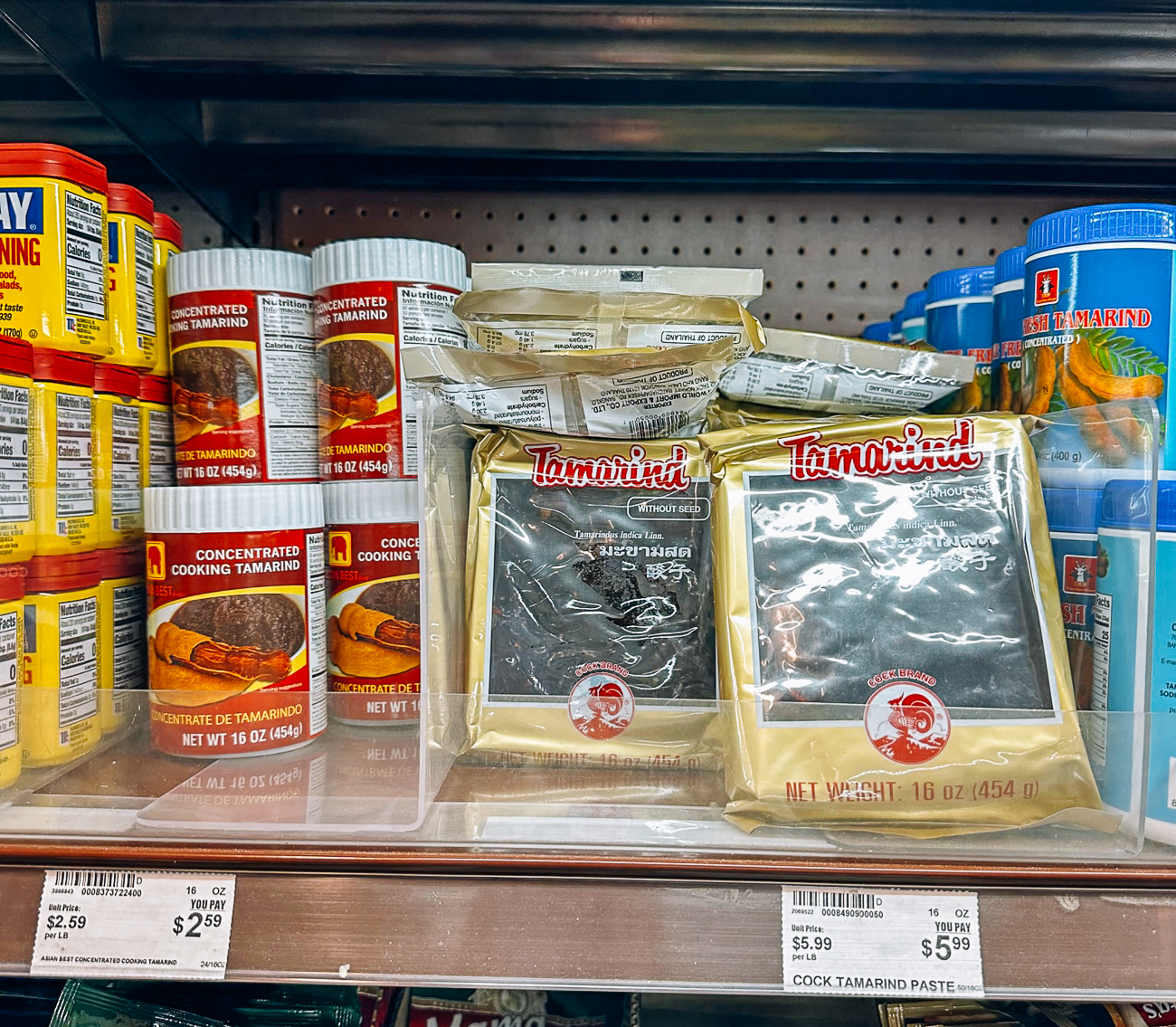
- Thai Soy Sauces: Thai soy sauces are different from Japanese or Chinese soy sauces, and there are different kinds! Thai sweet soy sauce, for instance, is much thicker and sweeter than say, a Chinese dark soy sauce. It really rounds out the flavors in the sauce base. Over the years, we’ve really come to respect the many nuances of regional soy sauces (Chinese, Japanese, Thai, etc.). While it seems like they might all taste the same, they definitely do not! How about adding “soy sauce snob,” alongside the craft beer experts and hot sauce aficionados?
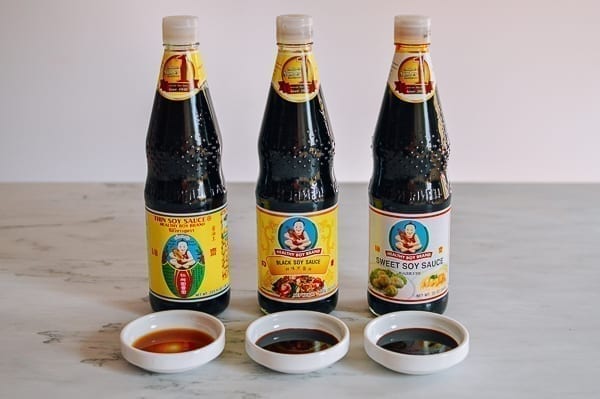
- Ground Dried Shrimp: Hear me out. Even though this isn’t a Shrimp Pad Thai with big whole shrimp, that shrimpy seafood flavor is a true hallmark of a good Pad Thai. Like anchovies, they really meld with all the other flavors in the dish. No overt fishiness here! Just depth of flavor. (We used the dried shrimp on the left in the photo below.)
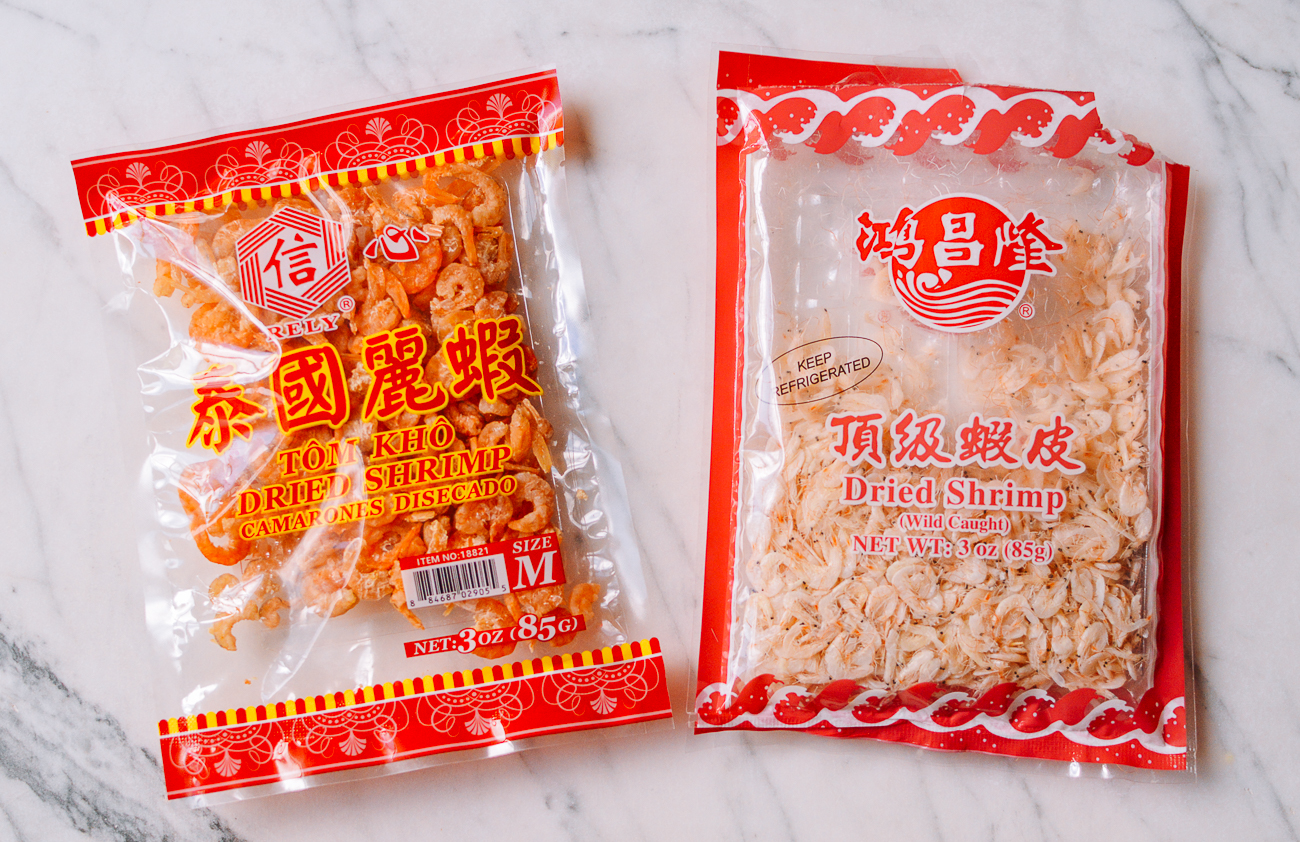
A Note on Dried Shrimp Sizes
Over the years, we’ve gotten many questions about what size dried shrimp to use in various recipes. On a recent trip to our local Chinese grocery store, I paid special attention to the dried shrimp section. Any size from XL through to L, M, S or even SS will do, so long as it has a darker orange hue. We generally prefer M or L. For XL, you may end up paying more money for not much of a flavor difference in your pad thai.
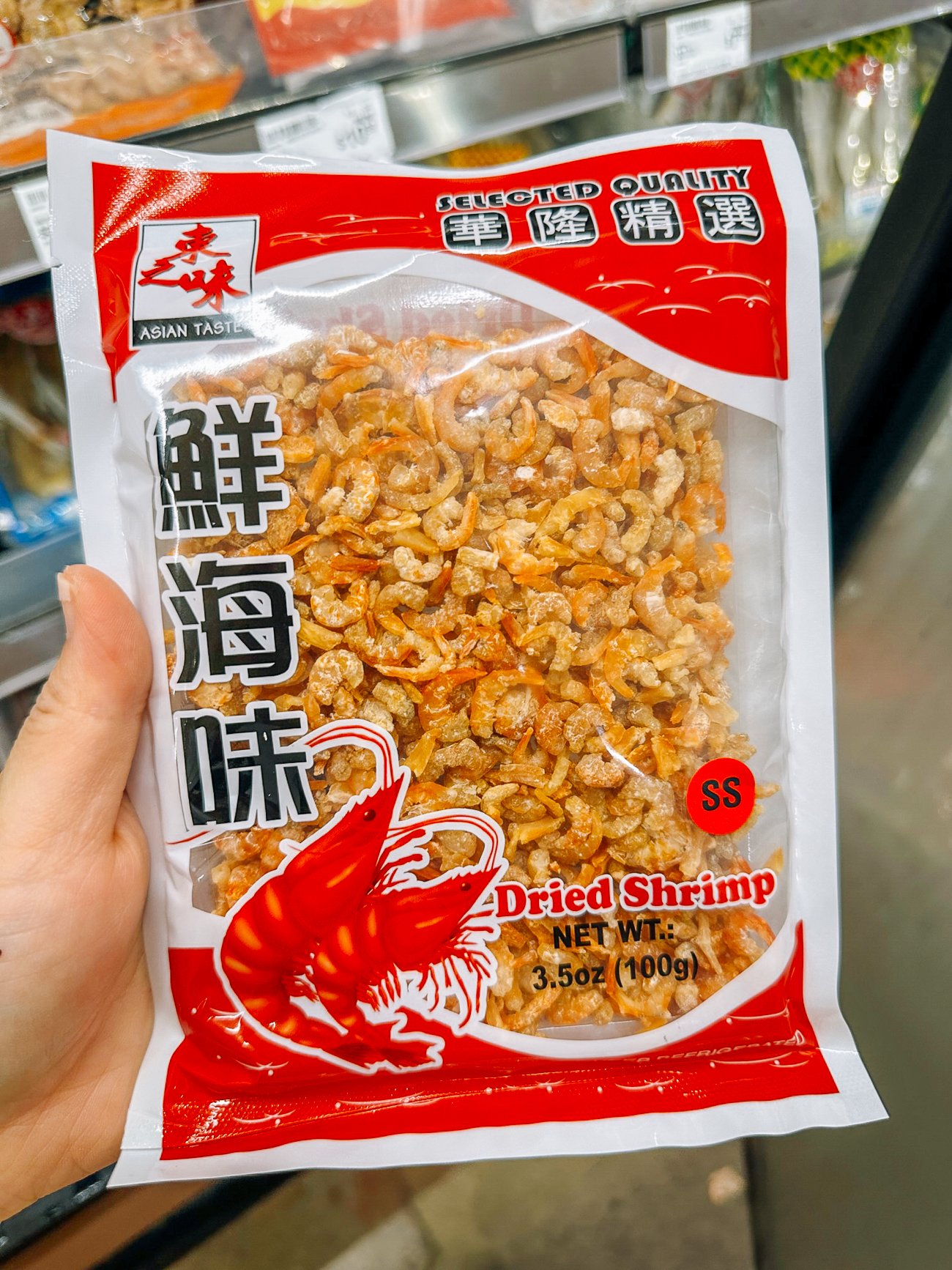
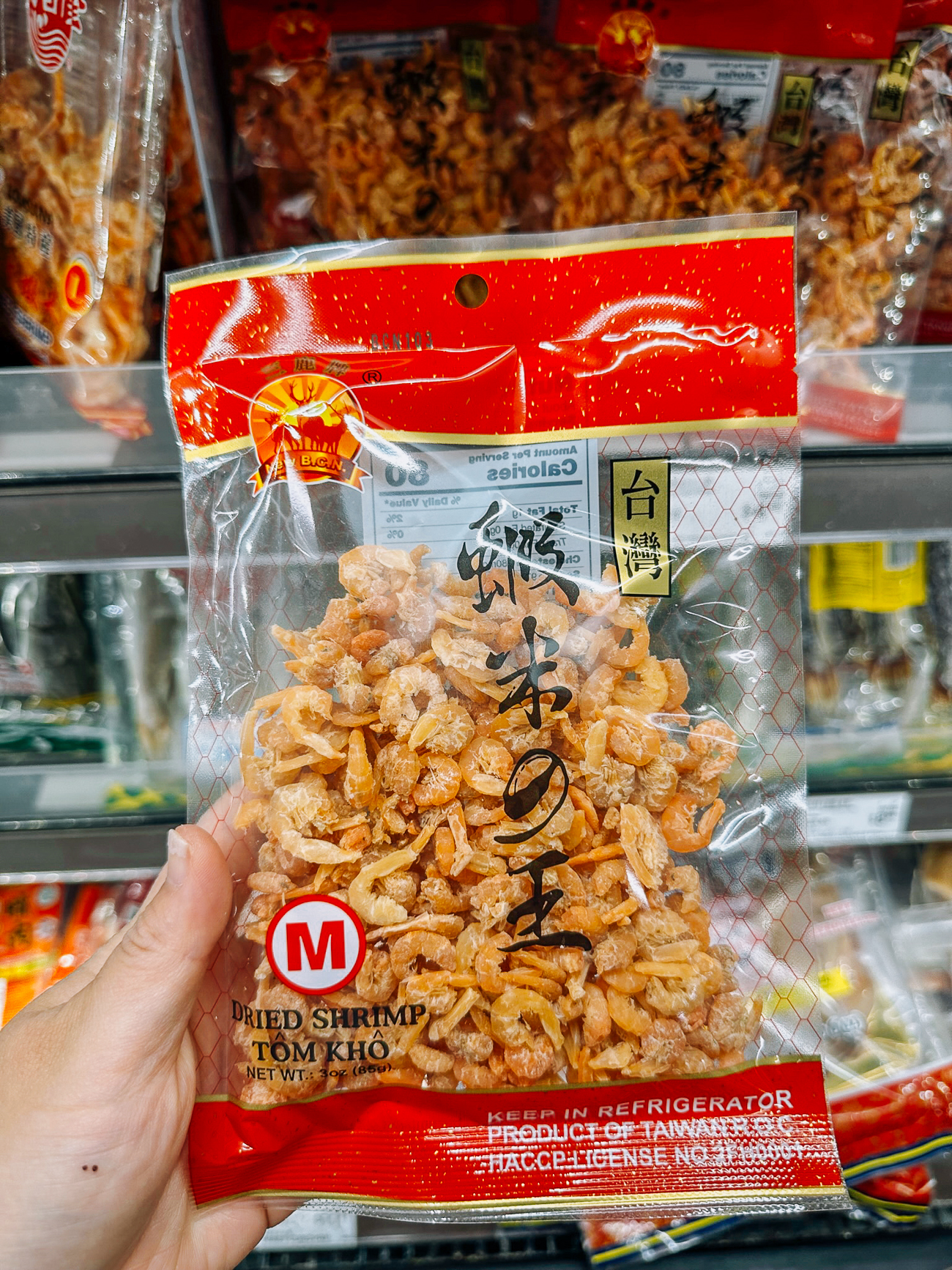
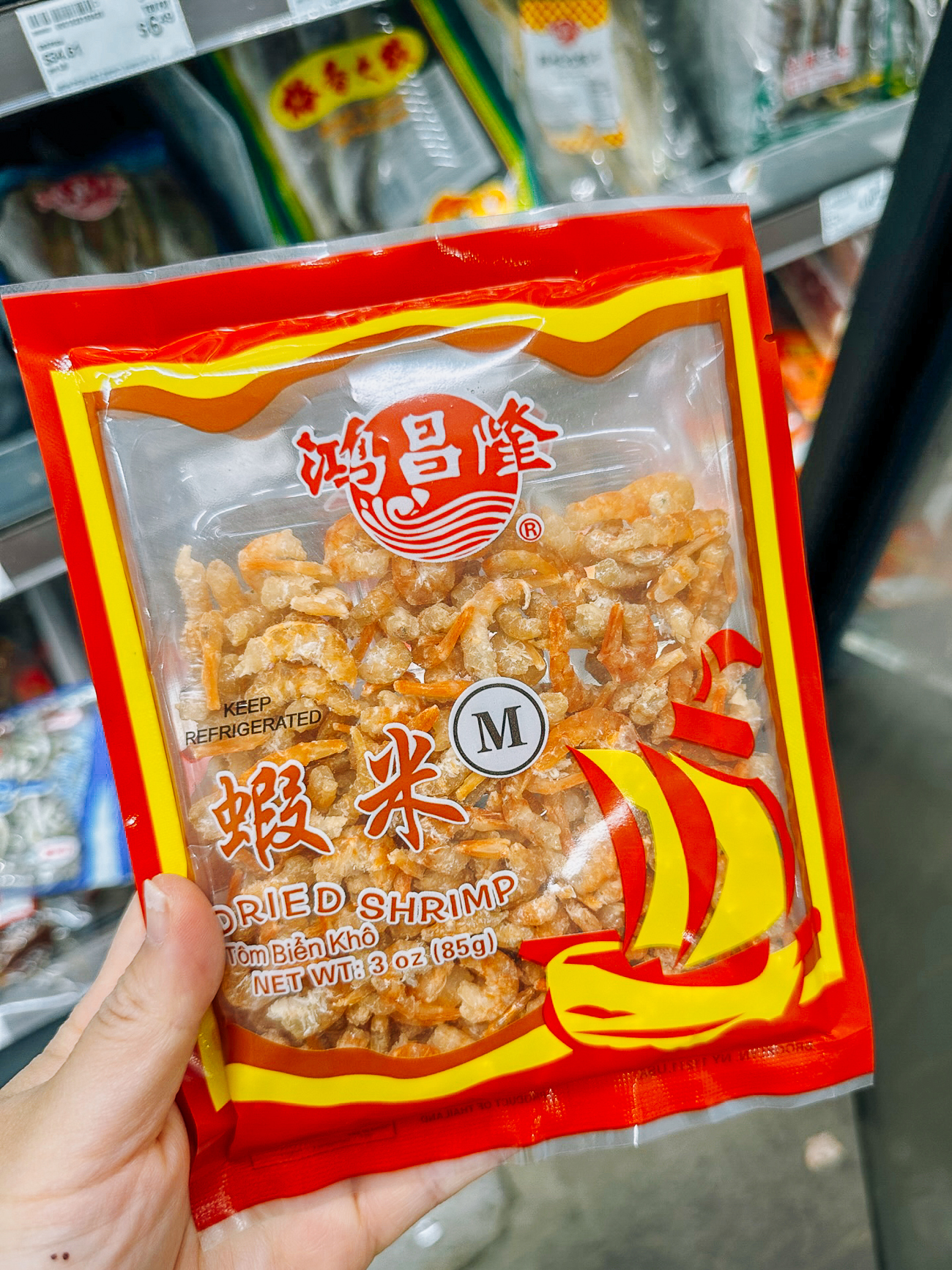
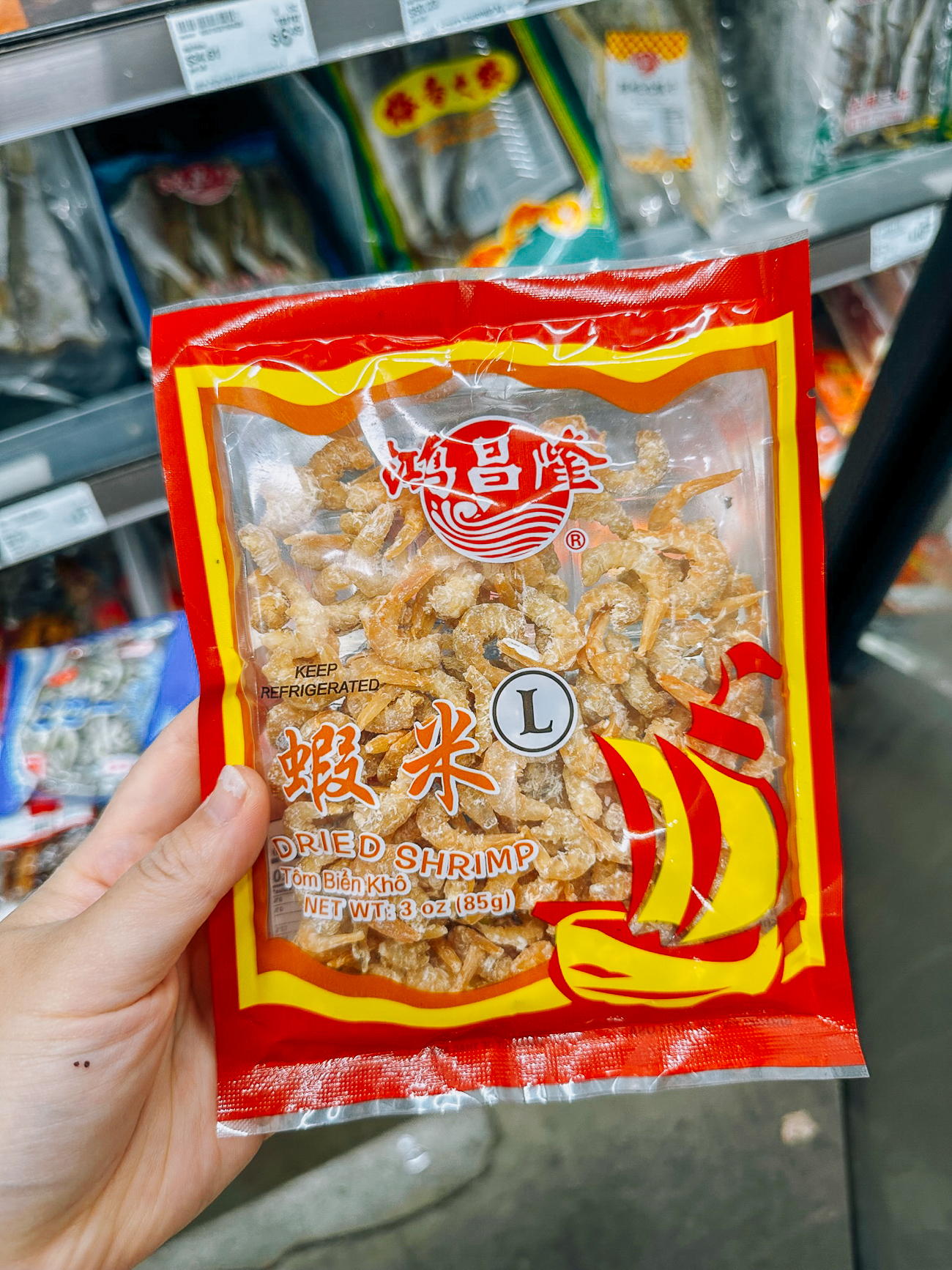

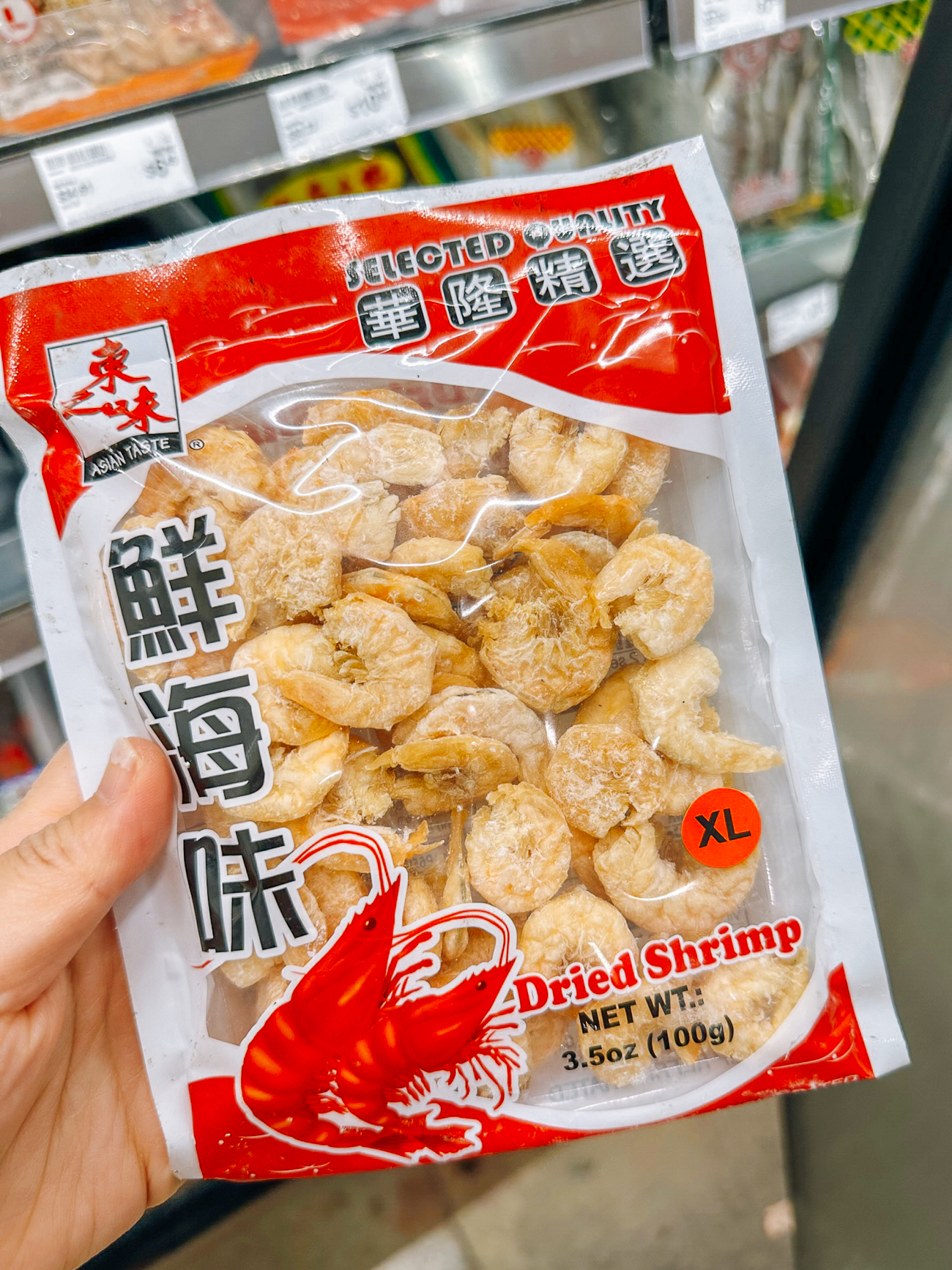
Feathery xiāpí shrimp (the extra tiny ones we call for in our wonton soup, for example) aren’t as suitable, as they’ll have less of that deep umami flavor that comes with the larger, darker orange-hued sizes.
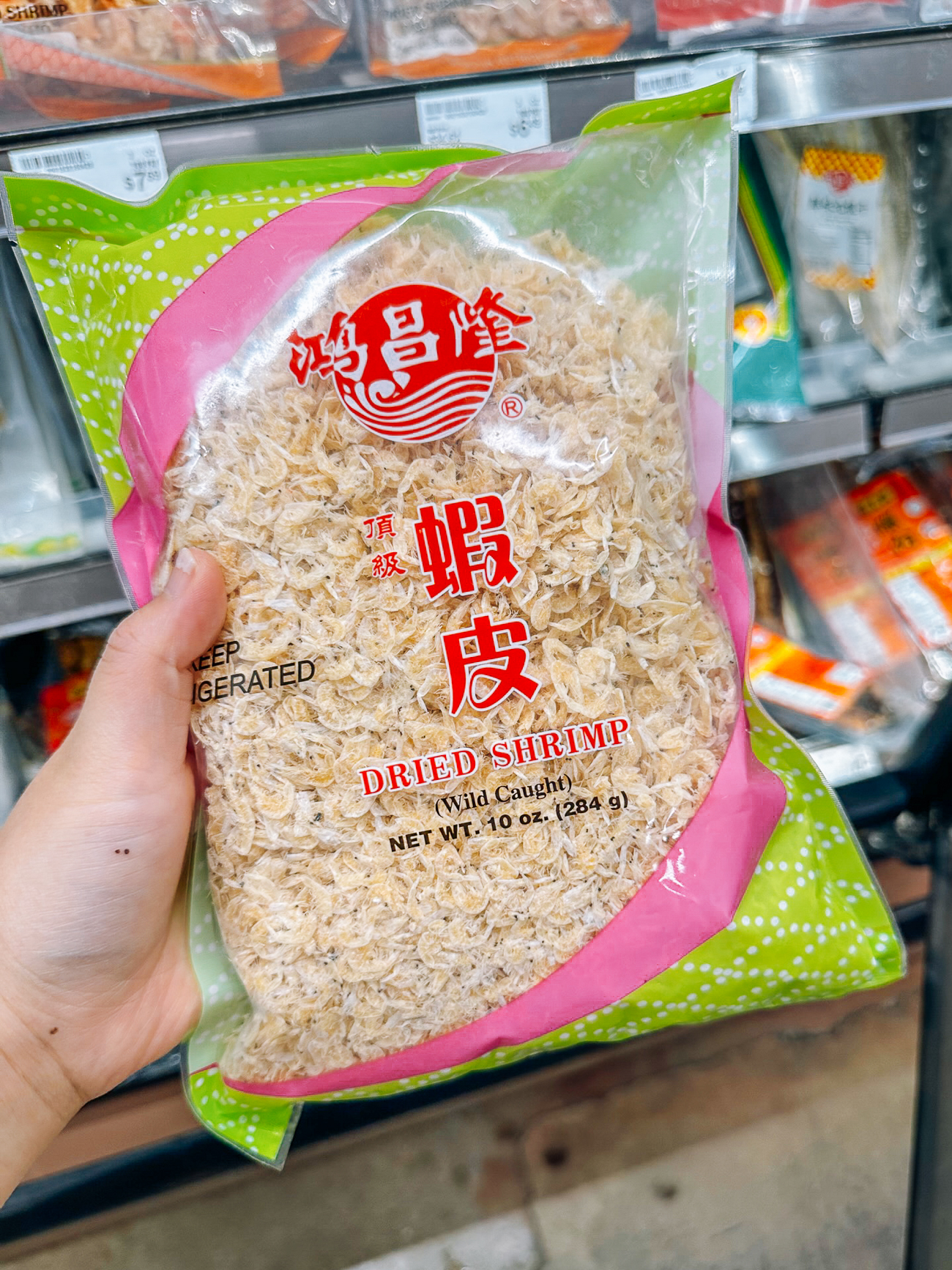
That said, if the shrimp flavor is too strong for you generally, you can feel free to reduce the amount according to your own tastes!
- Fish Sauce: When you have that seafood edge coming from both the dried shrimp and fish sauce, that’s when you start to get lightyears ahead of anything you could find in a takeout container. We’ve really come to like Red Boat fish sauce if you can find it!
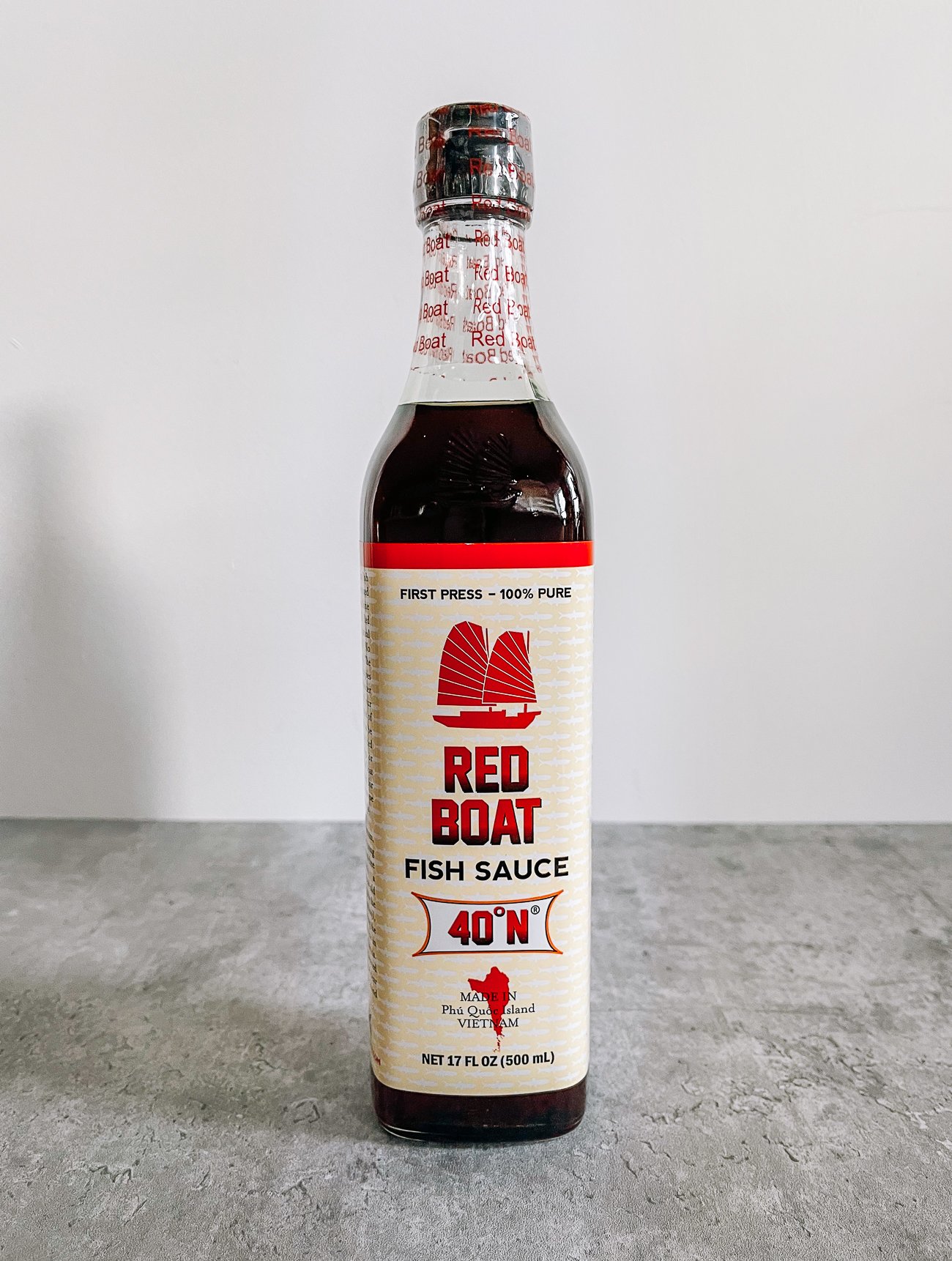
- Preserved Salted Radish: Adds complexity and a subtle pickle-y, salty bite to your pad Thai. Find it in vacuum-sealed packages!
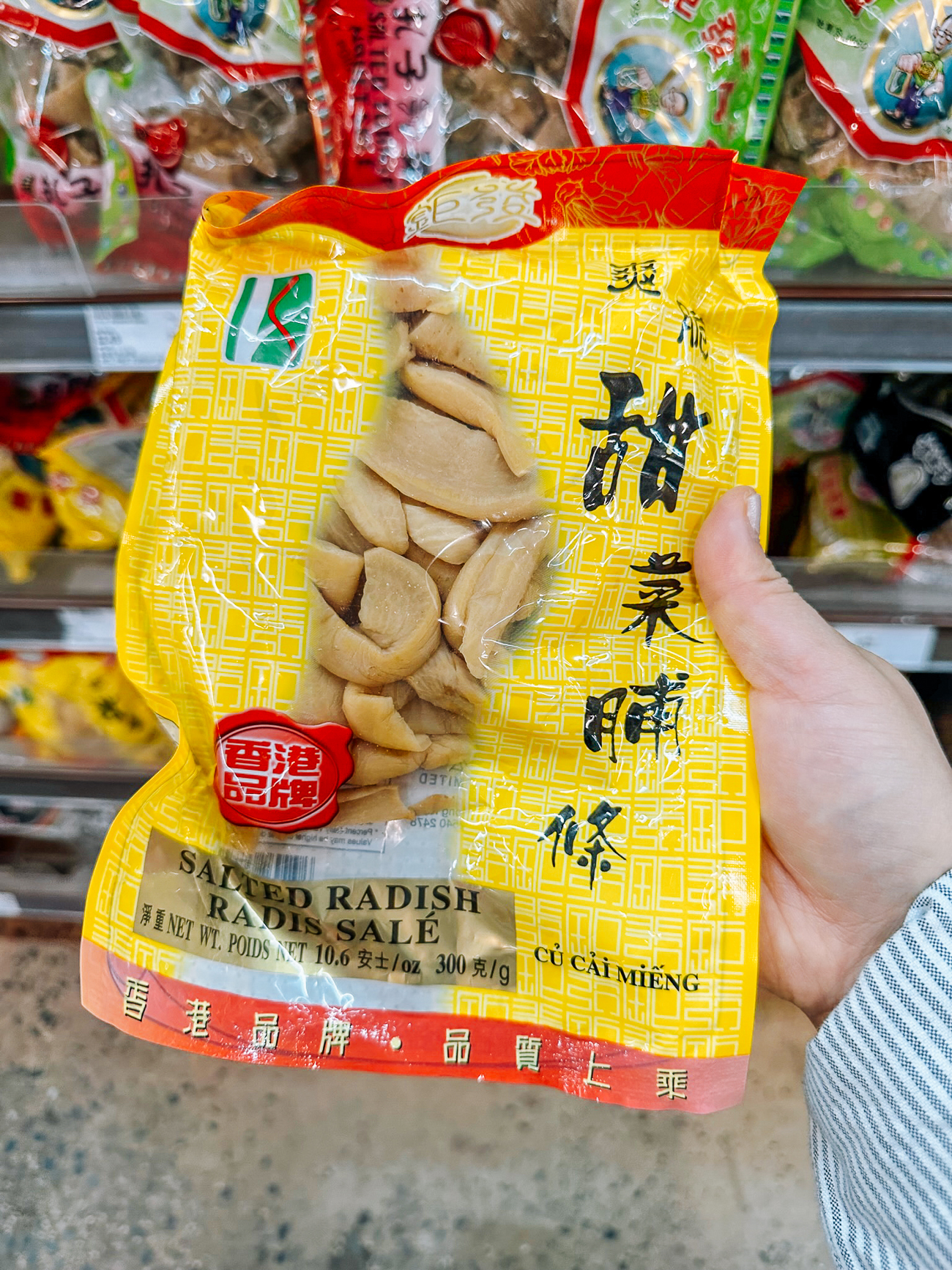
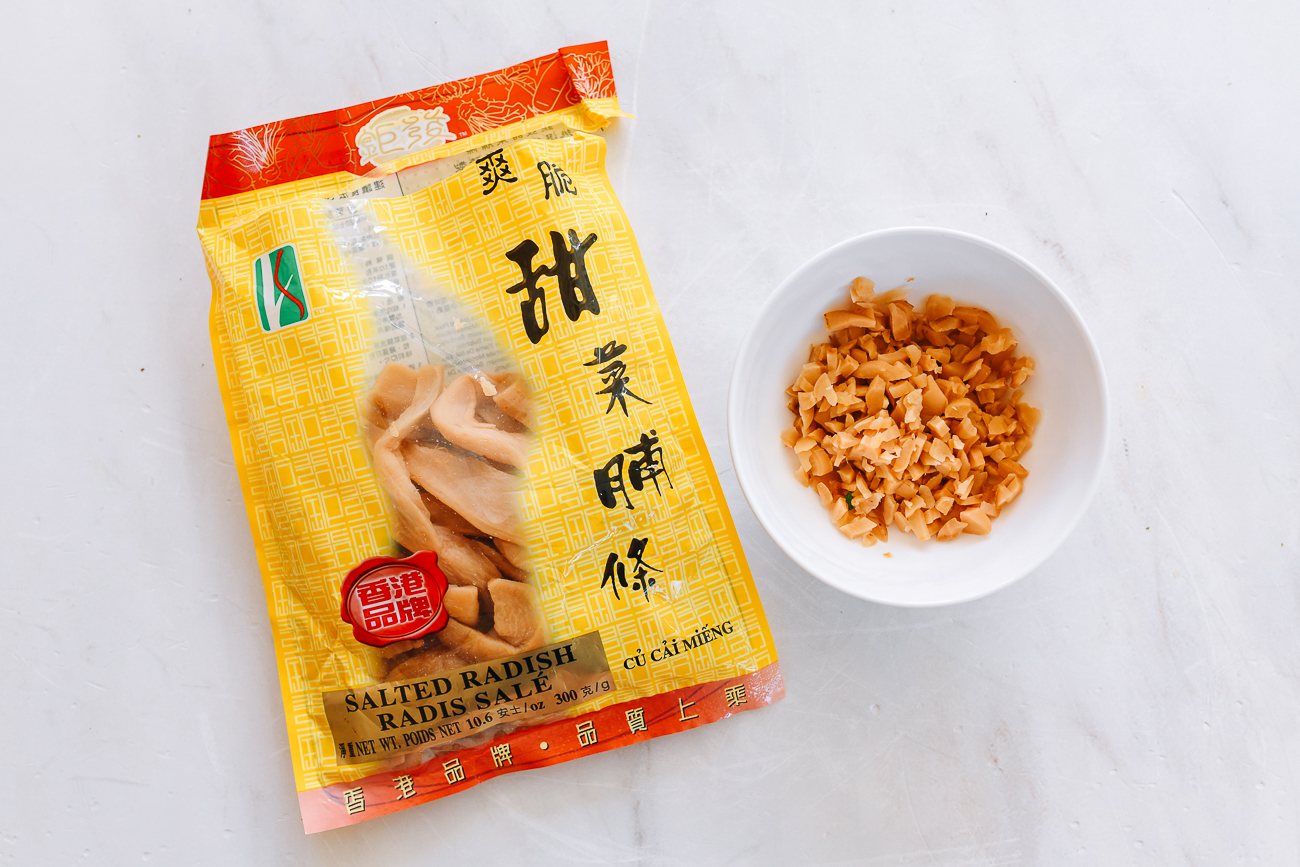
- Garlic Chives: Also known as Chinese Chives, garlic chives are wider and flatter than the regular chives you’re probably familiar with. They have a sweet garlic flavor, essential to any plate of good Pad Thai.
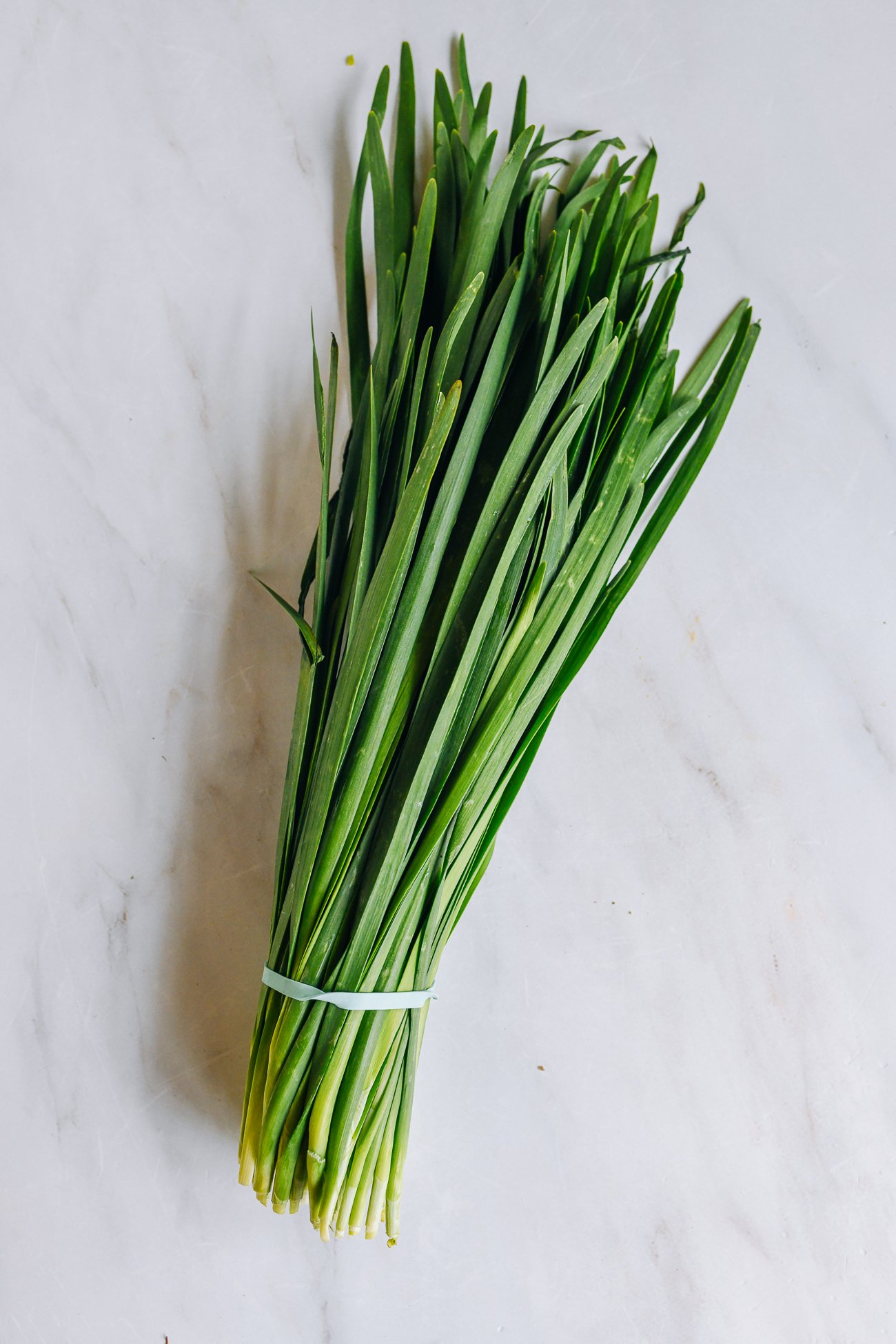
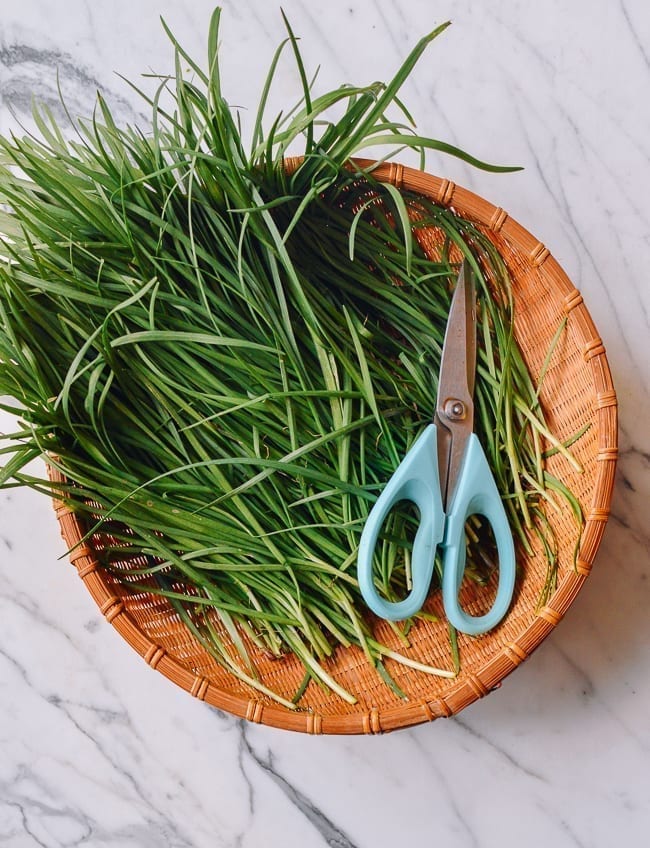
Long story short: if you’re wondering about substitutions, try your best to stick to the recipe! This is one where it’s tough to cut out anything, especially if you want to achieve the full scope of flavors. Trust us. You won’t regret following this recipe as written.
That said, we understand that many of you have limited access to ingredients. Here are some substitutions you could consider:
- If you can’t find the Thai thin, black, and sweet soy sauces, use Chinese light/dark soy sauce, and add an extra ½ teaspoon of sugar.
- If you can’t find Thai preserved salted radish (it can be hit or miss, depending on how well-stocked your Asian market is), you can substitute Chinese zha cai, preserved Chinese mustard stems (榨菜). The recipe calls for a relatively small amount, so if you can’t find either of those, you can omit it.
- If you truly hate the idea of using dried shrimp, you can experiment with adding 1 tablespoon of oyster sauce instead. That said, like an anchovy in a pasta sauce, the shrimp melds into the dish and adds a great umami flavor.
- Instead of Chinese chives, you can substitute scallions (green onions), but use half the amount called for. That said, they grow like grass, so plant your gardens or pots accordingly! (Learn more about how to grow garlic chives in your garden!)
When this dish is done, it will feel like you’ve indulged in your favorite Thai takeout—but YOU made it!
How to store spare ingredients
I got a good question in the comments about how to store leftover salted radish and tamarind blocks.
We store both in the refrigerator. Once opened, you can just roll up the bag of salted Thai radish and secure it with a rubber band. You can also pour it into an airtight container or resealable bag if you prefer. The same goes for the tamarind blocks. Both store really well in the refrigerator. They can probably last for at least 6 months like that.
Similarly, for the dried shrimp, we store those in the fridge in the bag they came in or if they’re opened and unwieldy, a resealable airtight container or bag. Because they’re dried already, you don’t have to be too precious about how they are stored.
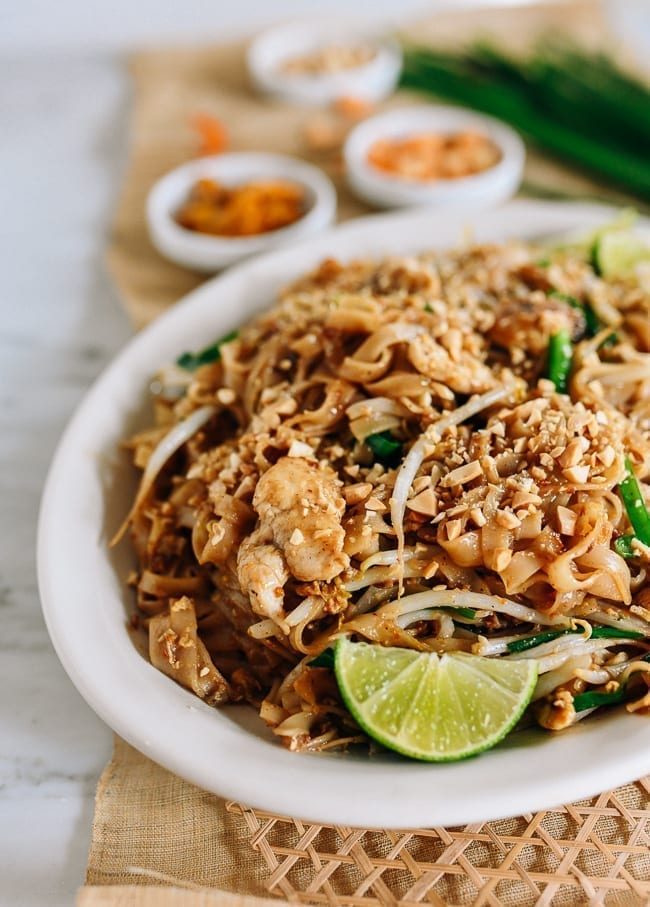
Pad Thai Recipe Instructions
First, make the sauce. Take the tamarind pulp (a block about 1 x 2 in (2.5 x 5 cm) and mix it with ½ cup boiling water (you can add a little more if needed to dissolve the paste).
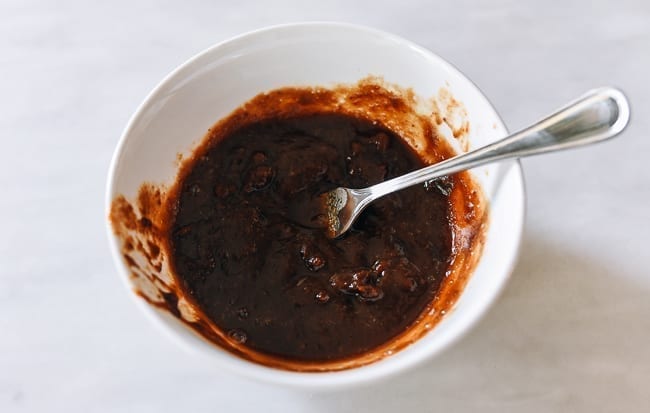
Break up the pulp in the hot water, and then press the mixture through a fine-meshed strainer. Discard the solids.
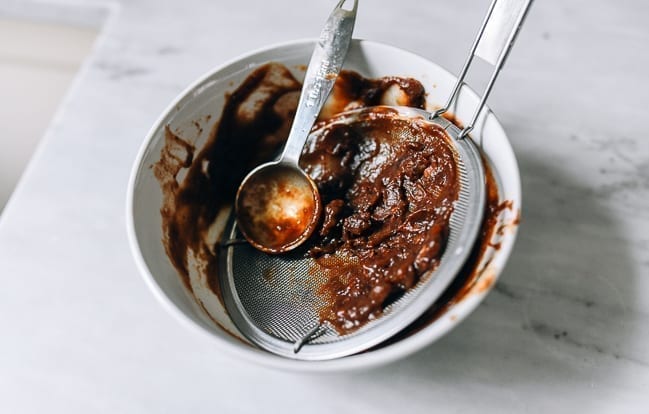
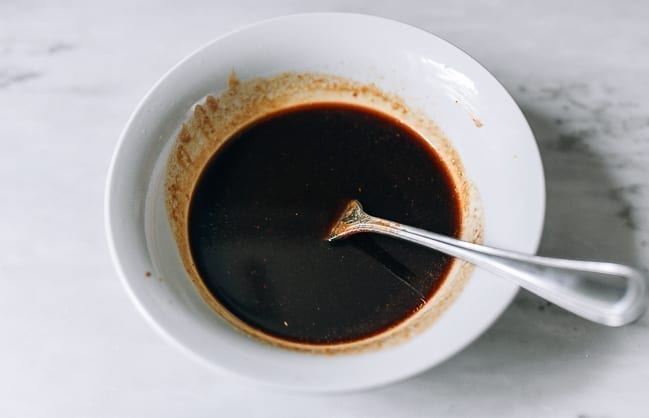
Alternatively, if using tamarind concentrate, measure out 6 tablespoons (90ml):
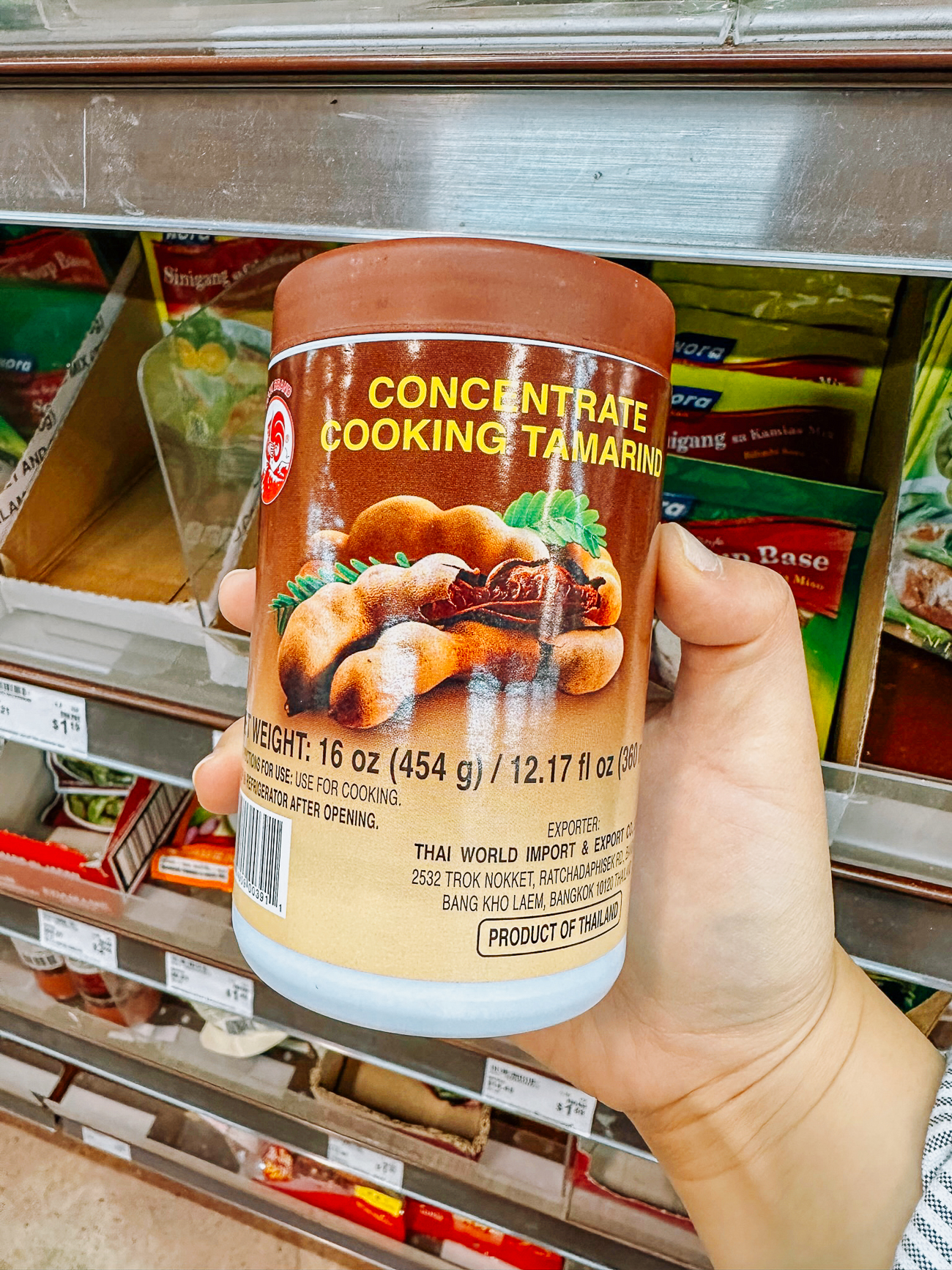
To the liquid tamarind concentrate you just made (or measured out), add the dark brown sugar (or palm sugar), fish sauce, Thai black soy sauce, Thai sweet soy sauce (if using), and white pepper. Set aside.
Using palm sugar
We’ve seen palm sugar come in a few different forms. Some are scoopable, some are hard small discs, and some are large discs. We used the smaller discs recently and microwaved them for 15-30 seconds with a damp paper towel loosely draped over the bowl. That softens them up enough to stir into your pad thai sauce. It doesn’t have to fully dissolve as it will do that when it hits the hot pan.
Soak the pad Thai noodles in hot water for about 20 minutes, and drain in a colander. If the noodles are in really long strands, you will want to cut them into 10- to 12-inch lengths to make stir-frying easier.
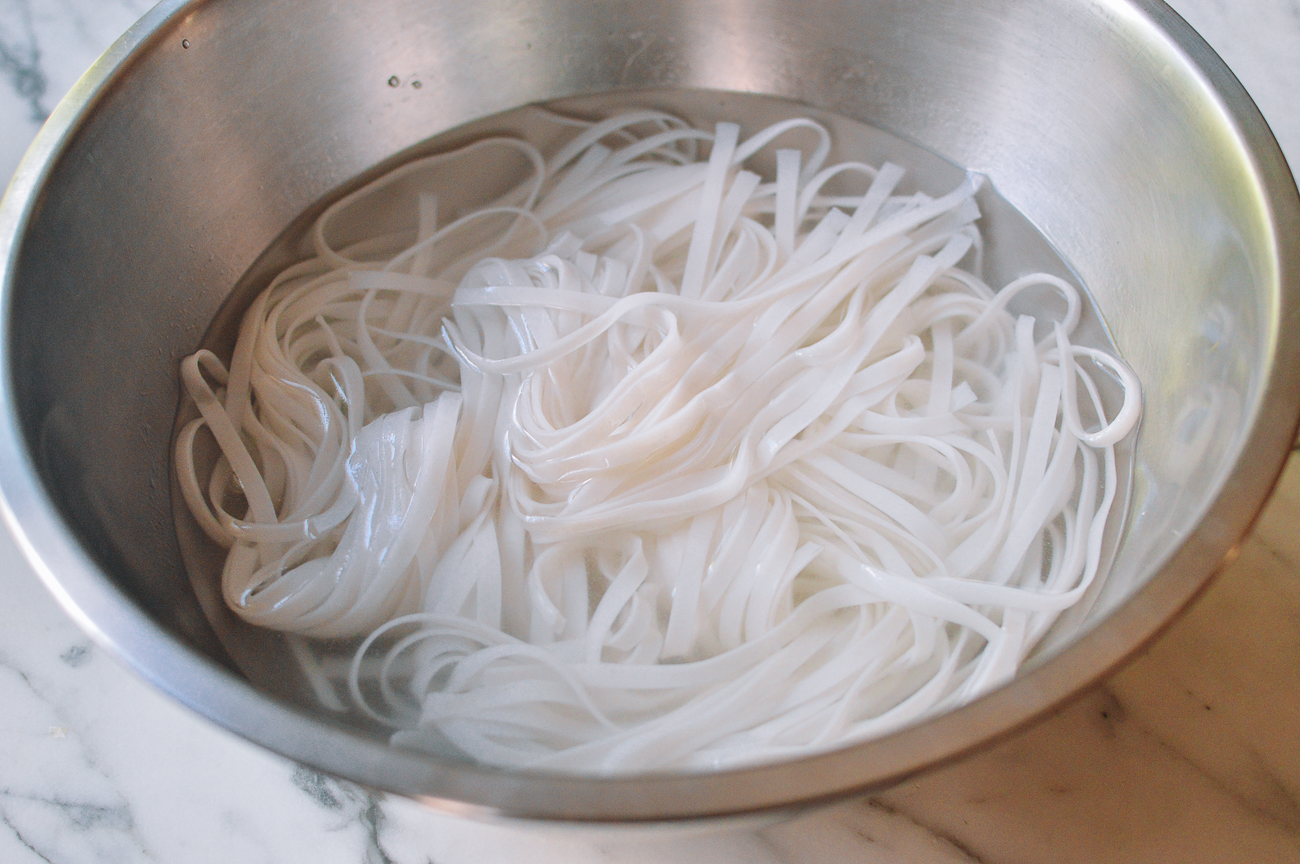
(Or you will end up with a huge noodle ball when cooking. Nobody wants a huge noodle ball.)
Marinate the sliced chicken by combining it with 1 teaspoon each of Thai thin soy sauce, cornstarch, and water. Set aside.
Next, prepare the dried shrimp, mincing them down into a coarse powder (we used a food processor).
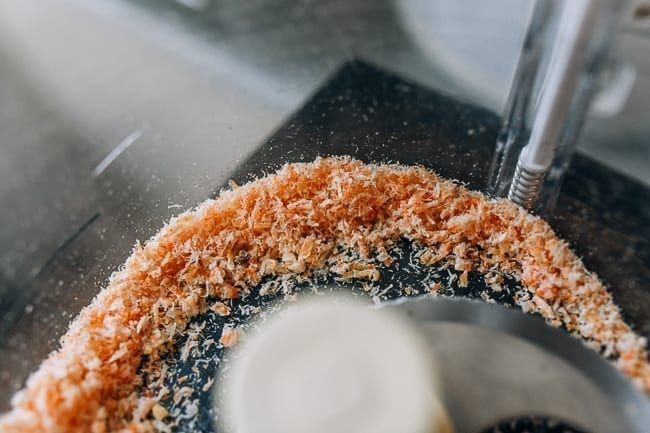
Prepare the garlic, shallots/red onion, Thai preserved salted radish or preserved Chinese mustard stems (zha cai), eggs, mung bean sprouts, garlic chives, and peanuts. You want to have everything ready to go before you turn on the stove.
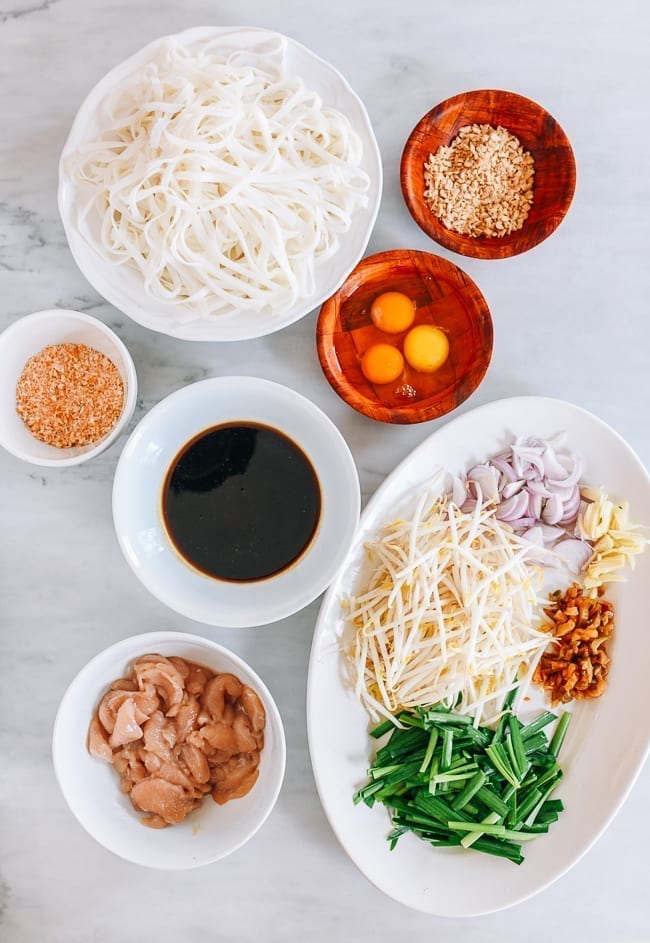
Now you’re ready to cook! Heat 2 tablespoons of oil in your wok over high heat until just smoking. Add the chicken, and sear until golden and just cooked through. Remove from the wok and set aside.
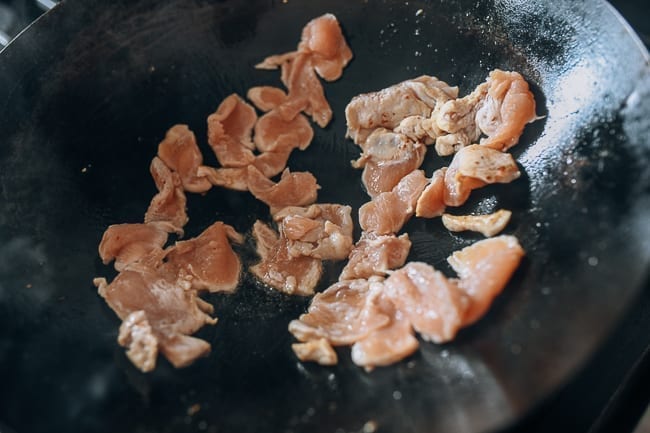
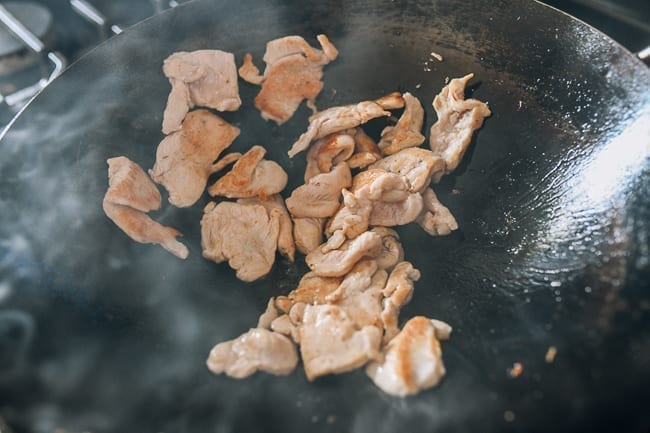
Add another 3 tablespoons of oil to the wok. Over medium heat, add the shrimp powder. Fry until fragrant and crisp, 2 minutes.
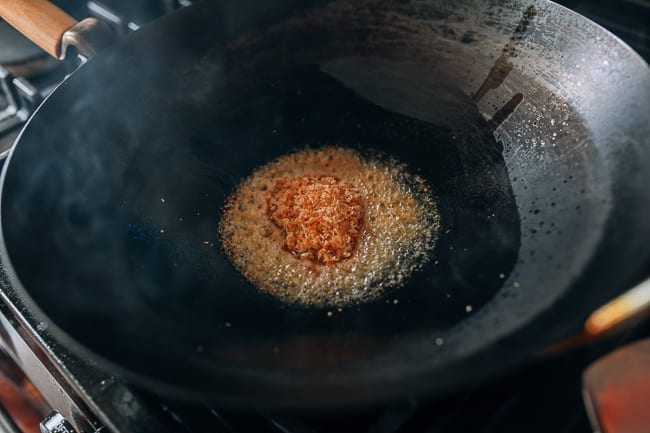
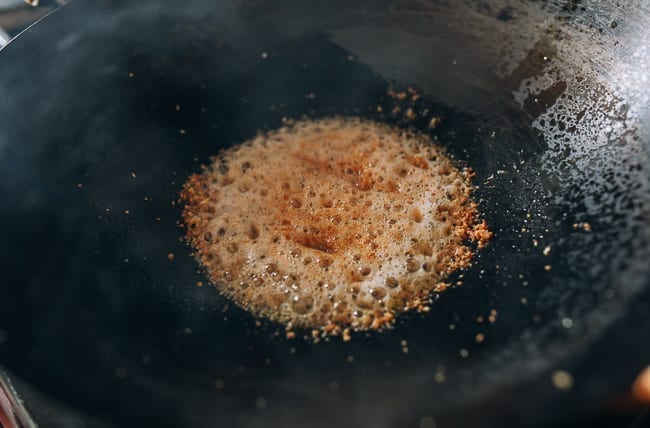
Add the garlic, and cook for 30 seconds.
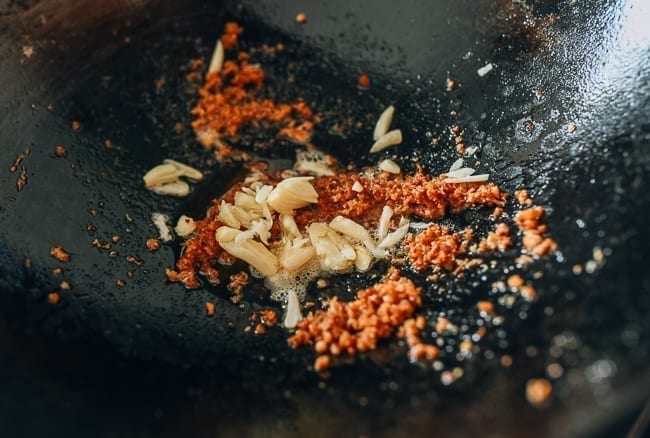
Add the shallots and salted radish or zha cai. Stir-fry for another 30 seconds.

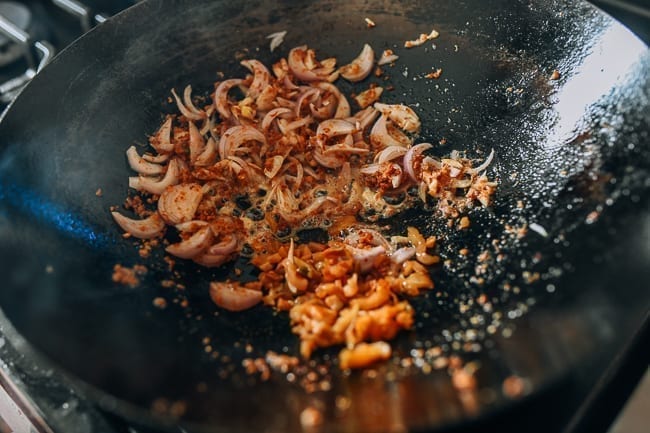
Turn the heat up to high, and add the noodles and sauce. Stir-fry and toss everything together to combine, lifting the noodles with your wok spatula to spread them out and break them up.
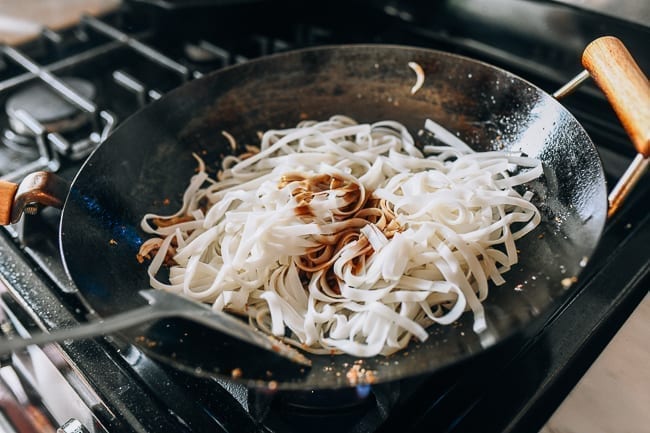
Make a space on the side of the wok, pushing the noodles to one side. Drizzle 1 more tablespoon of oil in the open space, and pour in the beaten eggs.
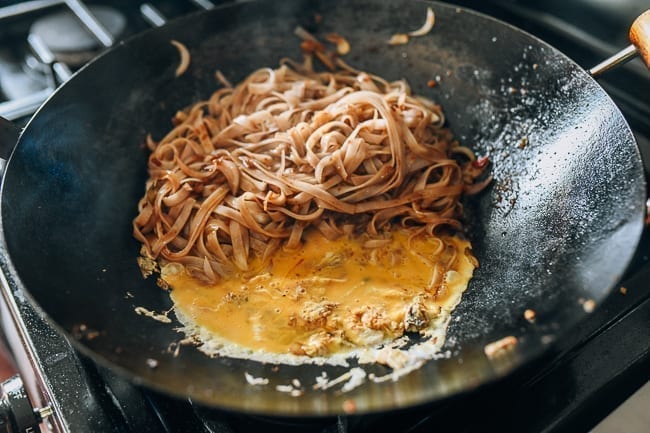
Use your spatula to fold them gently, scrambling them without breaking up the egg too much. When the eggs are about 70% done, stir-fry to distribute them into the noodles.
Next, add the bean sprouts and the chives.
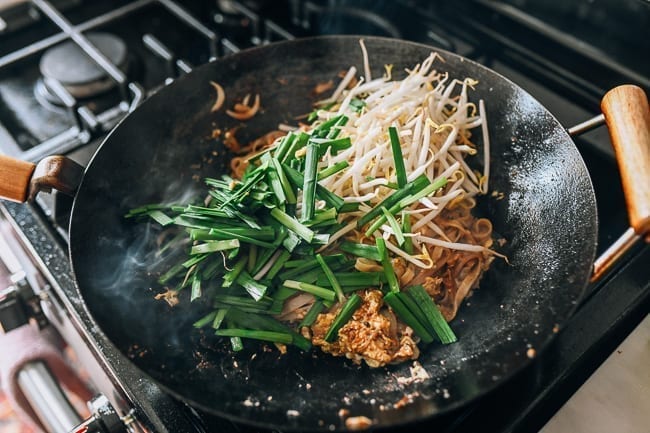
Stir-fry to combine, letting the chives wilt. Add the chicken back in.
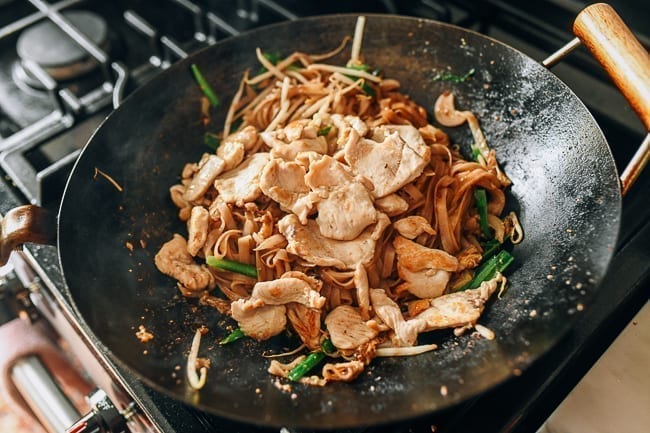
Stir-fry to combine until everything is incorporated.
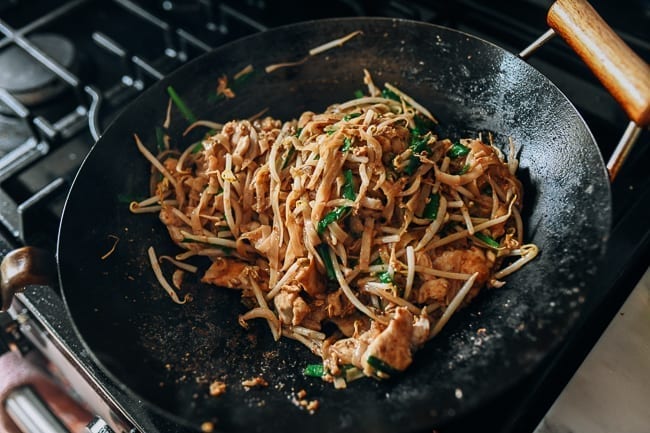
Plate, top with the crushed peanuts, and serve with lime wedges! A squeeze of lime juice brightens up all the other flavors in the dish.
Note that we staged this recipe with chopsticks, but in Thailand, it’s common to eat Pad Thai with a fork and a spoon! So if your chopstick skills aren’t the best, don’t worry. Do as the Thais do, and grab a fork!
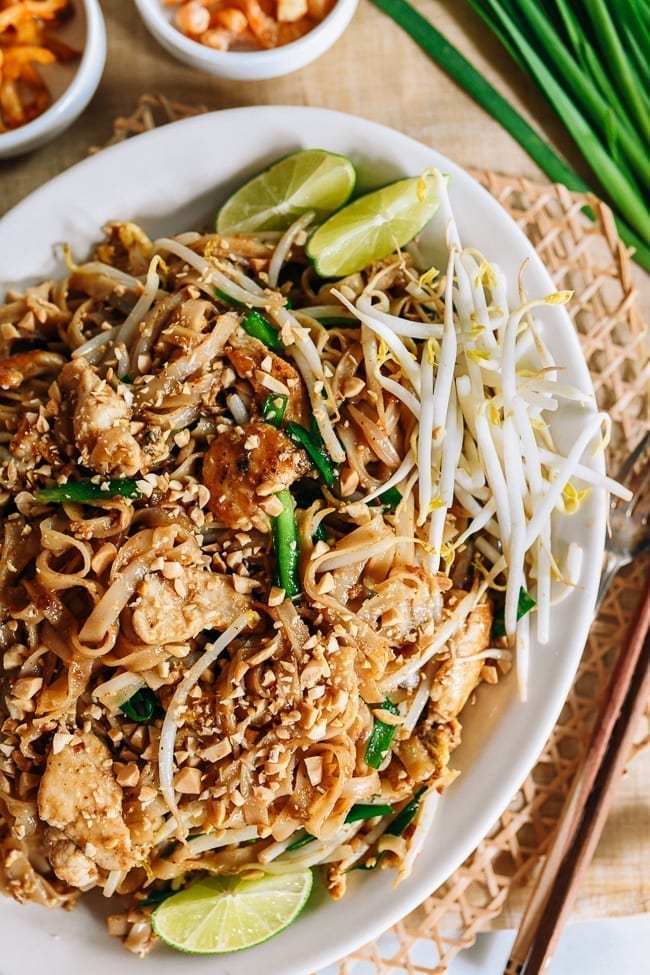
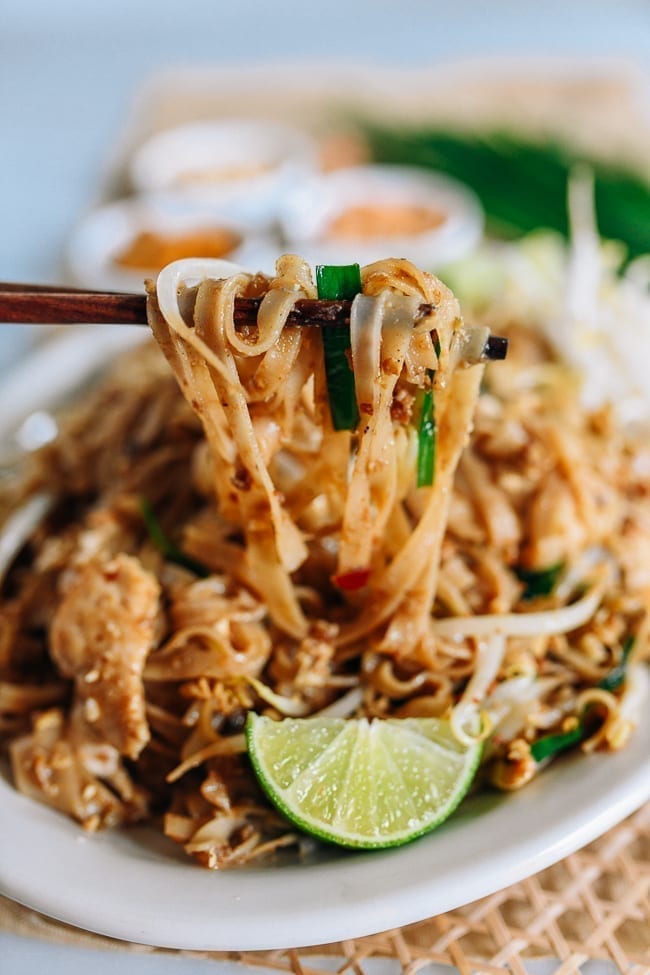
Looking for more authentic recipes? Subscribe to our email list and be sure to follow us on Pinterest, Facebook, Instagram, and Youtube!
Recipe
Pad Thai
Ingredients
For the Pad Thai sauce:
- 1.5 ounces tamarind pulp (plus ½ cup boiling water; or 6 tbsp/90ml tamarind concentrate)
- 3 tablespoons dark brown sugar (or palm sugar, if you can find it)
- 3 tablespoons fish sauce
- 2 tablespoons Thai black soy sauce (look for the “Healthy Boy” brand)
- 1 teaspoon Thai sweet soy sauce (optional)
- 1/4 teaspoon white pepper (to taste)
For the rest of the dish:
- 8 ounces dried Pad Thai rice noodles
- 8 ounces chicken breast (thinly sliced)
- 1 teaspoon Thai thin soy sauce
- 1 teaspoon cornstarch
- 1 teaspoon water
- 1/4 cup dried shrimp (small, medium, large, or XL size; minced or processed into a coarse powder)
- 3 cloves garlic (sliced)
- 2 large shallots (thinly sliced; can substitute red onion)
- 2 tablespoons preserved Thai salted radish (preferred) or Chinese mustard stem (rinsed in warm water and julienned; optional — preserved salted radish is a product of Thailand; if you can't find it, zha cai, works well)
- 3 large eggs (beaten, preferably at room temperature)
- 2 cups mung bean sprouts (washed and drained)
- 1 cup Chinese garlic chives (cut into 1-inch pieces)
- 2 tablespoons roasted peanuts (finely chopped)
- 6 tablespoons vegetable oil (divided)
- lime wedges (for serving)
Instructions
- First, make the sauce. Take the tamarind pulp (a block about 1 x 2 in (2.5 x 5 cm) and mix it with ½ cup boiling water (you can add a little more if needed to dissolve the paste). Break up the pulp in the hot water, and then press the mixture through a fine-meshed strainer. Discard the solids. To the liquid tamarind concentrate you just made, add the sugar, fish sauce, Thai black soy sauce, Thai sweet soy sauce (if using), and white pepper. Set aside.
- Soak the pad thai noodles in hot water for about 20 minutes, and drain in a colander. If the noodles are in really long strands, you will want to cut them into 10- to 12-inch lengths to make stir-frying easier.
- Marinate the sliced chicken by combining it with 1 teaspoon each of Thai thin soy sauce, cornstarch, and water. Set aside.
- Next, prepare the dried shrimp, mincing them down into a coarse powder (we used a food processor). Prepare the garlic, shallots/red onion, preserved salted radish or Chinese mustard stems (zha cai), eggs, mung bean sprouts, garlic chives, and peanuts. You want to have everything ready to go before you turn on the stove.
- Now you’re ready to cook! Heat 2 tablespoons of oil in your wok over high heat until just smoking. Add the chicken, and sear until golden and just cooked through. Remove from the wok and set aside.
- Add another 3 tablespoons of oil to the wok. Over medium heat, add the shrimp powder. Fry until fragrant and crisp, 2 minutes. Add the garlic, and cook for 30 seconds. Add the shallots and preserved salted radish (or zha cai). Stir-fry for another 30 seconds.
- Turn the heat up to high, and add the noodles and sauce. Stir-fry to combine, lifting the noodles with your wok spatula to spread them out and break them up.
- Make a space on the side of the wok, pushing the noodles to one side. Drizzle 1 more tablespoon of oil in the open space, and pour in the beaten eggs. Use your spatula to fold them gently, scrambling them without breaking up the egg too much. When the eggs are about 70% done, stir-fry to distribute them into the noodles.
- Next, add the bean sprouts and the chives. Stir-fry to combine, letting the chives wilt. Add the chicken back in, and stir-fry to combine until everything is incorporated. Plate, top with the crushed peanuts, and serve!





